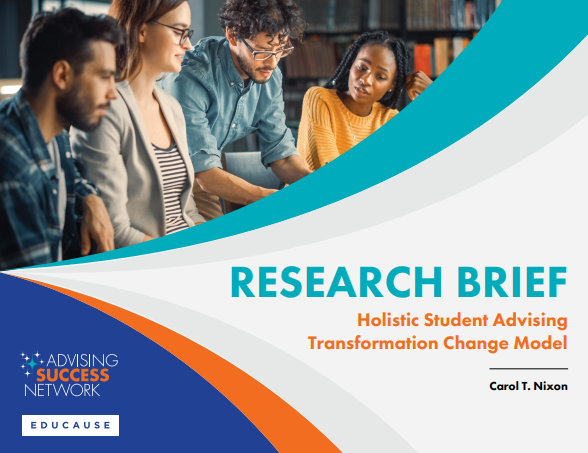Holistic Student Advising Transformation Change Model
Research Brief
Publication Date: 2022
Format: PDF

This research brief presents a holistic advising transformation change model that synthesizes research on how advising redesign influences student outcomes. Frames as a visual cycle, the model incorporates elements of both theory of change and program logic models to illustrate how institutional context shapes advising redesign efforts and capacity building efforts, which in turn impact student engagement, development, and outcomes. Intended as a strategic planning tool, the model supports institutions in determining when, why, and how to pursue advising transformation and offers guidance for strategic planning and implementation activities.
Connections to the Transformation Journey
and How Institutions Transform
Stages of Transformation
- Start the Process: This resource synthesizes literature on how advising transformation improves student outcomes, offering a macro level model that explains why, how, and when changes should occur. It highlights the connection between institutional context, planning, action, and impact making it particularly useful early in the transformation journey, when institutions are exploring multiple topics and practices to improve student outcomes.
Learn more about the Transformation Journey and How Institutions Transform.
Evidence-Based Practices
- Advising Reform: Focuses exclusively on holistic advising, this model outlines the main components of advising redesign including institution context, capacity building, activities, and performance indicators through the lens of advising practice. It draws on field research and perspectives of intermediary organizations to illustrate the conditions that support or hinder successful advising reform.
Learn more about the Transformation Journey and How Institutions Transform.
Continuous Improvement
This resource is most relevant to the following cross-functional roles:
- Senior Leaders: Offers a macro-level model of transformation contextualized to advising that can aid senior leaders in understanding, planning, implementing, monitoring, and telling the story of their institution’s efforts.
- Mid-Level Leaders: Especially relevant for mid-level leaders advocating for or charged with leading advising redesign efforts as a roadmap of the key structures, elements, and practices to be included in planning.
This resource connects to the following phase(s) of the PRPAM framework:
- Prepare: Useful for institutional leaders seeking to build buy-in around Advising as an evidence-based practice with the potential to improve priority student outcomes.
- Prioritize/Plan: Offers macro-level guidance for teams planning advising-related transformation efforts, including context and vision inputs, sequencing planning activities and redesign milestones, and evaluation and quality improvement practices.
Learn more about the Transformation Journey and How Institutions Transform.
Stages of Transformation
- Start the Process: This resource synthesizes literature on how advising transformation improves student outcomes, offering a macro level model that explains why, how, and when changes should occur. It highlights the connection between institutional context, planning, action, and impact making it particularly useful early in the transformation journey, when institutions are exploring multiple topics and practices to improve student outcomes.
Learn more about the Transformation Journey and How Institutions Transform.
Evidence-Based Practices
- Advising Reform: Focuses exclusively on holistic advising, this model outlines the main components of advising redesign including institution context, capacity building, activities, and performance indicators through the lens of advising practice. It draws on field research and perspectives of intermediary organizations to illustrate the conditions that support or hinder successful advising reform.
Learn more about the Transformation Journey and How Institutions Transform.
Continuous Improvement
This resource is most relevant to the following cross-functional roles:
- Senior Leaders: Offers a macro-level model of transformation contextualized to advising that can aid senior leaders in understanding, planning, implementing, monitoring, and telling the story of their institution’s efforts.
- Mid-Level Leaders: Especially relevant for mid-level leaders advocating for or charged with leading advising redesign efforts as a roadmap of the key structures, elements, and practices to be included in planning.
This resource connects to the following phase(s) of the PRPAM framework:
- Prepare: Useful for institutional leaders seeking to build buy-in around Advising as an evidence-based practice with the potential to improve priority student outcomes.
- Prioritize/Plan: Offers macro-level guidance for teams planning advising-related transformation efforts, including context and vision inputs, sequencing planning activities and redesign milestones, and evaluation and quality improvement practices.
Learn more about the Transformation Journey and How Institutions Transform.
Recommended Citation: Nixon, C. T., EDUCAUSE (2022, November 14). Holistic Student Advising Transformation Change Model. Advising Success Network. https://www.advisingsuccessnetwork.org/advising-tool-equity/a-change-model-for-holistic-advising-redesign/


